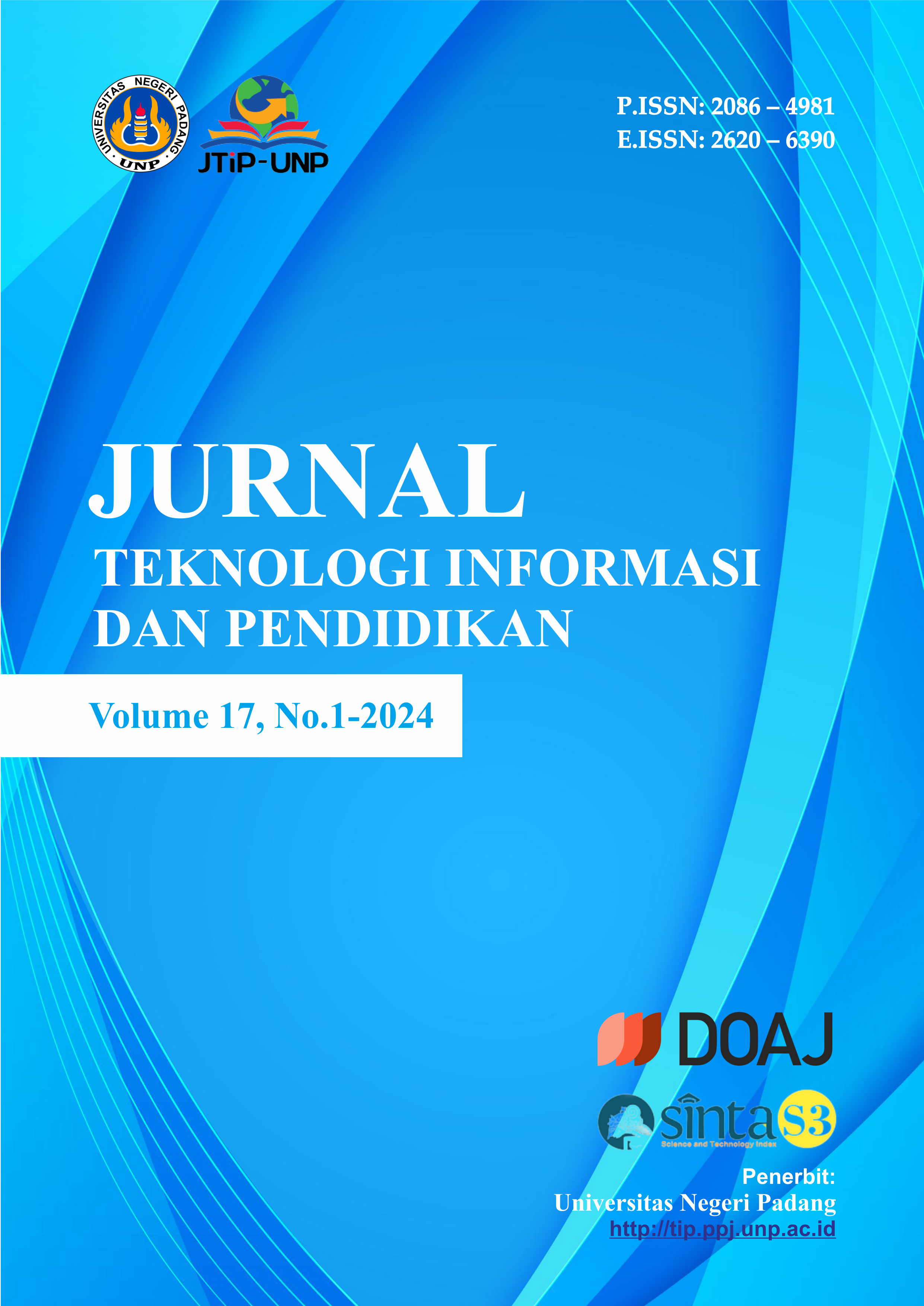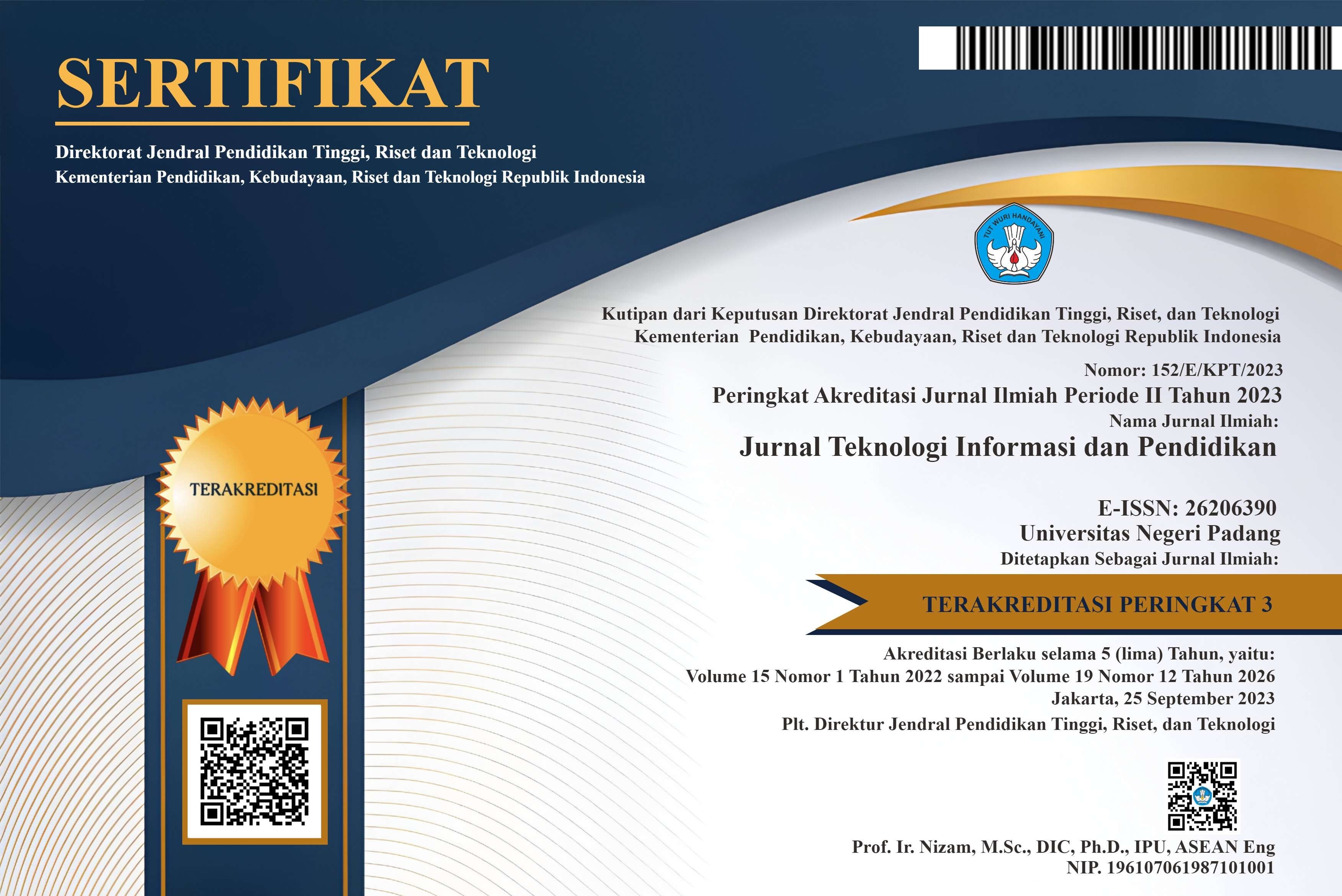Application of Fuzzy Logic Controller for Measurement of Body Temperature and Heart Rate
Abstract
In the development of electronic technology, especially robots, they have played an important role in the medical field, including for overcoming the anxiety of autistic children and their health. This study used a SAR (Socially Assistive Robot) robot equipped with a heart rate and body temperature sensor to help reduce and indicate the anxiety and also health of autistic children. The MAX30100 sensor was used to detect heart rate, while the GY906 sensor was used to detect body temperature. The robot's response resembled a hand movement, which was a sign that a child's body temperature and heart rate were out of the ordinary (abnormal). The aim was to provide assistance to autistic children in dealing with anxiety and their health, making it easier for teachers to supervise autistic children, which could affect their emotional and social development. By using a fuzzy logic controller to analyze the response of MAX30100 sensors and GY906 sensors working optimally or not, with servo motor output.
References
A. A. Adenle, K. Wedig, and H. Azadi, “Sustainable agriculture and food security in Africa: The role of innovative technologies and international organizations,” Technol. Soc., vol. 58, no. 1, pp. 1–54, 2019, doi: 10.1016/j.techsoc.2019.05.007.
N. Khan, R. L. Ray, G. R. Sargani, M. Ihtisham, M. Khayyam, and S. Ismail, “Current progress and future prospects of agriculture technology: Gateway to sustainable agriculture,” Sustain., vol. 13, no. 9, pp. 1–31, 2021, doi: 10.3390/su13094883.
M. Bertola, A. Ferrarini, and G. Visioli, “Improvement of soil microbial diversity through sustainable agricultural practices and its evaluation by -omics approaches: A perspective for the environment, food quality and human safety,” Microorganisms, vol. 9, no. 7, pp. 1–22, 2021, doi: 10.3390/microorganisms9071400.
E. Z. Baskent, “A framework for characterizing and regulating ecosystem services in a management planning context,” Forests, vol. 11, no. 1, pp. 1–20, 2020, doi: 10.3390/f11010102.
M. Javaid, A. Haleem, I. H. Khan, and R. Suman, “Understanding the potential applications of Artificial Intelligence in Agriculture Sector,” Adv. Agrochem, vol. 2, no. 1, pp. 15–30, 2023, doi: 10.1016/j.aac.2022.10.001.
M. Javaid, A. Haleem, R. P. Singh, and R. Suman, “Enhancing smart farming through the applications of Agriculture 4.0 technologies,” Int. J. Intell. Networks, vol. 3, no. 7, pp. 150–164, 2022, doi: 10.1016/j.ijin.2022.09.004.
N. Khan, M. A. Kamaruddin, U. U. Sheikh, Y. Yusup, and M. P. Bakht, “Oil palm and machine learning: Reviewing one decade of ideas, innovations, applications, and gaps,” Agric., vol. 11, no. 9, pp. 1–26, 2021, doi: 10.3390/agriculture11090832.
M. S. Suchithra and M. L. Pai, “Improving the prediction accuracy of soil nutrient classification by optimizing extreme learning machine parameters,” Inf. Process. Agric., vol. 7, no. 1, pp. 72–82, 2020, doi: 10.1016/j.inpa.2019.05.003.
S. K. S. Durai and M. D. Shamili, “Smart farming using Machine Learning and Deep Learning techniques,” Decis. Anal. J., vol. 3, no. 3, pp. 1–30, 2022, doi: 10.1016/j.dajour.2022.100041.
X. Peng, X. Yu, Y. Luo, Y. Chang, C. Lu, and X. Chen, “Prediction Model of Greenhouse Tomato Yield Using Data Based on Different Soil Fertility Conditions,” Agronomy, vol. 13, no. 7, pp. 1–19, 2023, doi: 10.3390/agronomy13071892.
Y. Shahare et al., “A Comprehensive Analysis of Machine Learning-Based Assessment and Prediction of Soil Enzyme Activity,” Agric., vol. 13, no. 7, pp. 1–18, 2023, doi: 10.3390/agriculture13071323.
D. Ganesh, K. J. A. Yeshwanth, M. Satheesh, M. G. S. V. Reddy, T. Chirudeep, and S. N. K. Polisetty, “Extreme Learning Mechanism for Classification & Prediction of Soil Fertility index,” J. Pharm. Negat. Results, vol. 13, no. 6, pp. 37–43, 2022, doi: 10.47750/pnr.2022.13.S06.006.
Z. Aslam, N. Javaid, A. Ahmad, A. Ahmed, and S. M. Gulfam, “A combined deep learning and ensemble learning methodology to avoid electricity theft in smart grids,” Energies, vol. 13, no. 21, pp. 1–24, 2020, doi: 10.3390/en13215599.
M. Alipour and D. K. Harris, “Increasing the robustness of material-specific deep learning models for crack detection across different materials,” Eng. Struct., vol. 206, no. 2, pp. 1–14, 2020, doi: 10.1016/j.engstruct.2019.110157.
C. Chen and H. Liu, “Dynamic ensemble wind speed prediction model based on hybrid deep reinforcement learning,” Adv. Eng. Informatics, vol. 48, no. 4, pp. 1–15, 2021, doi: 10.1016/j.aei.2021.101290.
K. Lavanya, A. J. Obaid, I. S. Thaseen, K. Abhishek, K. Saboo, and R. Paturkar, “Terrain mapping of landsat8 images using mnf and classifying soil properties using ensemble modelling,” Int. J. Nonlinear Anal. Appl., vol. 11, no. 1, pp. 527–541, 2020, doi: 10.22075/IJNAA.2020.4750.
A. Gasmi, C. Gomez, A. Chehbouni, D. Dhiba, and M. El Gharous, “Using PRISMA Hyperspectral Satellite Imagery and GIS Approaches for Soil Fertility Mapping (FertiMap) in Northern Morocco,” Remote Sens., vol. 14, no. 16, pp. 1–22, 2022, doi: 10.3390/rs14164080.
K. Pragathi, “Crop Yield Prediction, Forecasting and Fertilizer Recommendation using Voting Based Ensemble Classifier,” Int. J. Innov. Res. Technol., vol. 8, no. 6, pp. 510–516, 2021, doi: 10.14445/23488387/ijcse-v7i5p101.
N. V. V. P. Mella and V. M. Pentakoti, “Crop yield prediction and Fertilizer Recommendation using Voting Based Ensemble Classifier,” J. Eng. Sci., vol. 13, no. 8, pp. 262–270, 2022, doi: 10.14445/23488387/ijcse-v7i5p101.
S. Karlos, G. Kostopoulos, and S. Kotsiantis, “A Soft-Voting Ensemble Based Co-Training Scheme Using Static Selection for Binary Classification Problems,” Algorithms, vol. 13, no. 1, pp. 1–19, 2020, [Online]. Available: https://doi.org/10.3390/a13010026
K. Pawlak and M. Kołodziejczak, “The role of agriculture in ensuring food security in developing countries: Considerations in the context of the problem of sustainable food production,” Sustain., vol. 12, no. 13, 2020, doi: 10.3390/su12135488.
X. Wang, “Managing Land Carrying Capacity: Key to Achieving Sustainable Production Systems for Food Security,” Land, vol. 11, no. 4, pp. 1–21, 2022, doi: 10.3390/land11040484.
G. T. Reddy et al., “An Ensemble based Machine Learning model for Diabetic Retinopathy Classification,” in International Conference on Emerging Trends in Information Technology and Engineering, ic-ETITE 2020, 2020, pp. 1–6. doi: 10.1109/ic-ETITE47903.2020.235.
N. Peppes, E. Daskalakis, T. Alexakis, E. Adamopoulou, and K. Demestichas, “Performance of machine learning-based multi-model voting ensemble methods for network threat detection in agriculture 4.0,” Sensors, vol. 21, no. 22, pp. 1–17, 2021, doi: 10.3390/s21227475.
A. Taha, “Intelligent ensemble learning approach for phishing website detection based on weighted soft voting,” Mathematics, vol. 9, no. 21, pp. 1–13, 2021, doi: 10.3390/math9212799.
L. Liu et al., “Deep neural network ensembles against deception: Ensemble diversity, accuracy and robustness,” Proceedings - 2019 IEEE 16th International Conference on Mobile Ad Hoc and Smart Systems, MASS 2019. pp. 274–282, 2019. doi: 10.1109/MASS.2019.00040.
A. Abbasi, A. R. Javed, C. Chakraborty, J. Nebhen, W. Zehra, and Z. Jalil, “ElStream: An Ensemble Learning Approach for Concept Drift Detection in Dynamic Social Big Data Stream Learning,” IEEE Access, vol. 9, no. 1, pp. 1–12, 2021, doi: 10.1109/ACCESS.2021.3076264.
G. Saxena, D. K. Verma, A. Paraye, A. Rajan, and A. Rawat, “Improved and robust deep learning agent for preliminary detection of diabetic retinopathy using public datasets,” Intell. Med., vol. 3–4, no. 1, pp. 1–11, 2020, doi: 10.1016/j.ibmed.2020.100022.
P. Srivastava, A. Shukla, and A. Bansal, “A comprehensive review on soil classification using deep learning and computer vision techniques,” Multimed. Tools Appl., vol. 80, no. 10, pp. 14887–14914, 2021, doi: 10.1007/s11042-021-10544-5.
O. Folorunso et al., “Exploring Machine Learning Models for Soil Nutrient Properties Prediction: A Systematic Review,” Big Data Cogn. Comput., vol. 7, no. 2, pp. 1–25, 2023, doi: 10.3390/bdcc7020113.
B. Charbuty and A. Abdulazeez, “Classification Based on Decision Tree Algorithm for Machine Learning,” J. Appl. Sci. Technol. Trends, vol. 2, no. 1, pp. 20–28, 2021, doi: 10.38094/jastt20165.
F. Rustam, M. Khalid, W. Aslam, V. Rupapara, A. Mehmood, and G. S. Choi, “A performance comparison of supervised machine learning models for Covid-19 tweets sentiment analysis,” PLoS One, vol. 16, no. 2, pp. 1–23, 2021, doi: 10.1371/journal.pone.0245909.
Copyright (c) 2023 Jurnal Teknologi Informasi dan Pendidikan

This work is licensed under a Creative Commons Attribution-ShareAlike 4.0 International License.















.png)














